

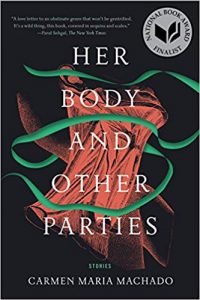


ENCW 202 Spring 2022
Apr 18th, 2022 by rhperry0033


Apr 13th, 2022 by Jess Munley

Apr 13th, 2022 by ashantibrown
Apr 12th, 2022 by Emma Alexander
Apr 11th, 2022 by accazares9715
Apr 7th, 2022 by Grace Quintilian
Apr 5th, 2022 by steinle22
“The Semplica Girl Diaries” by George Saunders is a first person narrative by a less-than-affluent father of two daughters and one son. The narrative is written as journal entries that span over a year in time, with fragmented sentences and rambling thoughts. The format of the writing and language used creates convincing journal entries.
Within the story there are many moments of discrepancy between lower class and upper class, highlighted by the differences in Lilly’s versus Leslie’s house, and specifically yard. It is intentional that the yard is emphasized as a key difference between the different classed families, as the yard is an outward representation of what is inside. Semplica girls (SGs) act as an adornment to this outward representation, and stand as a symbol of wealth and status to the characters in the story.
The SGs however are a grotesque actuality of attempting to show off status or indulge in what has been set as the status quo of class. They are exploited. Within the story this exploitation is not limited to the historically wealthy families, as the narrator ends up investing in SGs himself after winning a scratch-off ticket. He defends this investment as being a nice treat, and that the lives of the SGs now is better than their origins. This is a key argument many people use in defending exploitation of immigrant workers, or exploiting people with a grim background. Activists, and Eva, seem to be the only ones to question the morality of the SGs, and Eva questions her father and goes so far as to release the SGs. The sensitivity and innocence that Eva displays cuts through the cognitive dissonance her father has, though not fully, as by the end of the story he still does not fully grasp Eva’s point of view, but he considers it.
Apr 5th, 2022 by ashantibrown
The story “Semplica Girl Diaries” was incredibly written to me. The way that the story actually takes shape as a diary was something that I did not expect even though it was in the title. The story, while having a very important message, also takes a comical route with portraying this message. The use of stereotypes is very prevalent, but the way the author introduces them it puts them in a comical light which can also make it easier to understand.
The stereotype that is touched on right at the beginning. I really like a line that the author wrote that I think touches on a feeling that a lot people have, but don’t admit that they are feeling.
Just reread the last entry and should clarify. Am not tired of work. It is a privilege to work. I do not hate the rich. I aspire to be rich myself. And when we finally do get our own bridge, trout, treehouse, SGs, etc., at least will know we really earned them, unlike, say, the Torrinis, who, I feel, must have family money.
It is a bit ironic that the narrator points out that they do not hate the rich, but also goes on to discredit a rich family that they know. I think that a lot of others can relate to what the author pointed out here. There is also a lot of comparison in the story between the rich and the poor. The want to be accepted by other families of high status, but also the narrator’s own children/family. I think there could also be a hint of self pleasure as well. I found this to be a very interesting contrast.
Apr 5th, 2022 by blazer16
In “Semplica Girl Daires” a father starts writing in a journal about his day. The family is not rich but also not poor but somewhere in the middle. Their daughter, Lily, has a birthday coming up and she wants things that are out of their budget. But one day the father wins $10,000 in a scratch off ticket and the family decides to throw Lily a surprise birthday party. He goes all out for the party and makes the neighbors jealous with their lawns and the SGs in the front yard. The children start to feel bad about the SGs and decides to set them free without telling their parents.
This leads to a big problem with the parents, cops and the company that they bought the SGs from. The parents accidently talked about losing the house in front of the children. This made the children upset and the parents had to calm them down and tell them that they are not going to lose the house. The parents cannot tell the cops what happen because they do not want the children to have this on their record.
This story is about being happy with what you got. Things might turn around for a little bit but don’t spend all that money on things that are useless. What matters most is being together and happy.
Apr 5th, 2022 by mmwilliams5180
Reading The Semplica Girls Diaries really through me for a loop. At first I thought we would just be getting a story about a Father, his life, and inner thoughts. Saunders did do a great job in creating the MC and letting us into his inner world about the struggles with money, with children, and everything else an adult has to deal with everyday. But as the story goes on we find that this story is actually much darker. At a party for one of his daughter’s rich friends we are introduced to the Semplica Girls who are referred to often as SGs. SGs are girls who have come from other countries looking for shelter and a better life to live. This girls are nothing more than landscape objects and symbols of status. Basically modern day slavery.
While I read this I can’t help but read this with mindset that I am reading through the point of view of a slaveowner basically. Everyone in this society does not look at the girls as people but merely objects. Even when the girls run away the MC asks “why would they run away when they were being treated well?” they ran away because they are people and they are allowed to want better for themselves than just being someone’s land ornament. Eva who is often described as “sensitive” is the only one with some humanity outside of her own status and saw the SGs as actual human girls so she let them go.When the family the poor the MC had a resented the rich for making poorer people feel less than. But the moment they get money the first thing they do is buy SGs. It is hypocritical but real that when people are in lower positions they think they are more humane and “realer” than the rich but often when people get any large sum of money their morals change. So I think the main lesson I learned from this story is the money is truly the root of evil in all societies past, present, and future.
Apr 5th, 2022 by zadarden1398
Apr 5th, 2022 by kemcconville1153
“The Semplica Girl Diaries” is a story about being grateful for what you have, as it could change any time. As well as this, it warns people how their lives can change if they make bad financial decisions, no matter how their upbringing was. This is shown with the main character, as he says that he once had a lot of clothes and was wealthy, but now he isn’t due to himself & his decisions. He buys his daughter Lilly figurines he cannot afford because he wants her to see him as a good father. So he buys her the figurines, or Semplica Girls (SGs). He cannot afford clothes for himself until he wins the lottery yet spends over $280 on SGs for Lilly’s birthday – he is desperate and jealous of Pam and Leslie’s wealth. He gets himself into further financial trouble after he cannot pay money for the SGs who escaped — he did not read his contract.
After he wins the lottery, he uses some of the money to renovate the yard for Lilly instead of using it to get out of debt. His daughter is his priority, but in an unhealthy, boastful way as he wants to boast about the things that he buys for Lilly. He exploits her and her SG collection as if it is a trophy. As well as this, the story is about greed/jealousy, public image, financial struggles, boastfulness, materialism, and obsession. The obsession and materialism are shown when he shows Leslie how his SGs are by the pond, boasting about the new and improved collection. After Leslie talks about the SGs, her mother calls her a brat and tells her she cannot have a pond – he considers this “a win” for Lilly. Why is he making it into a competition that may pin the girls against each other? There are also other forms of obsession and public image in this story, such as Thomas’s mother’s obsession with him using the word “like.” She makes sure to tell him over and over not to use it. Eva has an obsession to “set herself apart from others” and makes herself look better and more refined.
Throughout the story, the main character asks what the future generation will grow up with. This may be his way of trying to hold on to the things he enjoyed in his life before he went into debt – this is his way of reminiscing. He explains that his life took a downward turn after he got blamed for his class having no recess as a child, due to a nun finding out about his mom’s divorce/affair and making everyone pray for her. He has lost a lot in life: the death of Todd, the loss of his parents’ marriage, and the loss of not being in debt. This is why he asks the future generation about airplanes, encyclopedias, and demons. He wants them to hold on to memories and what they own before they lose both of those things.
He may be disrupting Lilly’s childhood with comparing her to Eva. Lilly as an adult may feel like she is not good enough/can’t live up to Eva, because of her father’s comparison. So, in a way, he is destroying a future generation by beginning generational trauma. Todd’s younger brother’s childhood was also disrupted, as he was treated second to Todd by his mother. Eva’s childhood is also disrupted by her mother, as it explains that she acts differently to gain attention, therefore; she is emotionally neglected by her mother. “This good, Pam and I feel: this = sign of intelligence, But Eva seems to have somehow gotten idea that sensitivity = effective way to get attention (…).” Eva eventually realizes that owning SGs is not morally right, and the fact that her family owns something morally wrong, SGs, is affecting her mental health and artwork. The main character doesn’t realize it is morally wrong, as he considers himself to be a savior of the SGs, as they had worse opportunities before. He isn’t as great of a person as he thinks he is. He has committed crimes of owning SGs and exploited them & held them illegally, like with women from other countries who are sold into sex crimes.
Apr 5th, 2022 by Jess Munley
“The Semplica Girl Diaries” by George Saunders is one of the most interesting stories we’ve read this semester, as well as one of the most boring. Its omission of many words like “I” and “are” gave it a new level. In the beginning, the narrator writes that he is keeping this diary for future generations. Perhaps this story is meant to be read as a future generation’s imperfect translation of the original diary, and that is why there are grammatical errors. If so, I think it could also be a commentary on how we look at historical wrongdoings. We look back to slavery and discrimination and wonder how it was ever a social normality to behave that way towards other human beings. With this story, I imagine the future generations wondering how it was ever considered even slightly okay, much less fashionable and cool, to string up women in your yard as decoration.
I realized how boring this story is when I noticed just how similar it is to real life. It isn’t new news that we do plenty of unacceptable things without thinking about whether or not we should be doing them. Additionally, none of the characters had unexpected personalities. Saunders seems to have based his characters on popular stereotypes. There is the typical father of a struggling-but-still-swimming family who loves his wife and kids and worries about others’ perceptions of him and the size of his wallet. There is the kind-hearted little girl who is too naive to know that these horrors aren’t actually horrors but good, acceptable parts of society. There is also the rich family, the bastard father-in-law, the racist guy named Jerry. They added to the political commentary of the story, but also made it into the type of story everyone already knows.
I did find the idea of Semplica Girls to be very new and unique. It’s an odd enough concept to be unrealistic but it is presented in a way that makes it seem as if, one day, with the right technology, upper class individuals might really start hanging girls up in their yards. If we could convince ourselves that we’re doing the Semplica Girls a favor, as the characters in the story do, then just how unlikely would it be? It lets wealthy individuals play into their white savior roles so they can commit human rights violations under the guise of helping those in need.
It’s fascinating that the rights of these women aren’t really brought up. The narrator doesn’t stop to consider that to hang in a yard for months and years on end would be detrimental to one’s mental abilities. Those girls are missing out on their educations, social lives, personal connections, physical exercise, and so much more. I can’t imagine they could ever function properly, physically or mentally, after spending so much of their formative years just hanging like Christmas ornaments. Where do they go when it’s storming, when it’s snowing, when the sun is blazing? All of this is just glossed over, clearly unimportant to the narrator, who is more concerned with appearing to have more money than he does. What injustices do we contribute to that we gloss over because they are normalized? Will future generations look upon us with the same disgust we look upon our ancestors with? More importantly, what can we do to right our wrongs?
Apr 5th, 2022 by accazares9715
“The Semplica Girl Diaries” by George Saunders is an epistolary story in which we learn about a middle-class father who struggles to keep his family happy as well as keeping the appearance of a wealthy family. The father throughout the story is a pitiful character whom the reader can sympathize with, since he is a character with redeeming qualities such as love for his family and a sense of self awareness. Hence, why the story seems to convey perfectly the themes of entitlement and ignorance.
Once the father bought the SGs for the family instead of clearing his debt, the reader sees where his priorities lie. Although it is clear that the father wants wealth and prestige, it seems like he wants the easy way towards these ideals. He does not pay the debts he owes but instead buys lavish gifts for his daughter Lilly, as well as buying the SGs to keep the appearance of wealth. Additionally, this allows for the reader to feel a connection with the father because his gifts to his daughter are out of genuine love and care, which allows for the reader to see the father in a better light. Furthermore, the father also is a perfect representation of people satisfied with the world. He is not a character who questions norms but follows them. He is the type of person who is content with how life is and does not want to change it. However, this also makes the father a realist. He is possibly aware that the ways in which the SGs live are not humane, but it is their way of life and their needs are met, allowing them to live a better life than they previously lived.
Hence, while I believe that the little girl Eva is correct in her stance, she is also naïve to the way in which the world works. By setting these woman free, Eva has condemned them to a life of running, as well as leaving her family in a rough position financially. Additionally, there does not seem to be many people who agree with her sentiment that owning SGs is wrong; therefore, there would not be many people willing to risk their wealth for the safety of the SGs. This also emphasizes how their father, although not right in having an SG, is simply living by the confines of his society. He has become unaware of the immorality of having an SG since it has been entrenched in his mind that SGs are a normal part of life. That’s why it is so easy for the father to dismiss Eva and her dislike of these ‘decorations’ because to his knowledge they are a normal part of life, which also has wealth attached to its usage.
Apr 5th, 2022 by elotocka0013
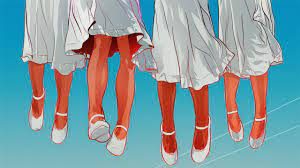 “The Semplica Girl Diaries” is told from the POV of a father struggling to make ends meet, who writes about his experiences in the diary that we read. The first person narration creates a very internal effect on the conflict, as it feels less about the problems that happen in the plot and more about how the father handles them. The first issue is that the family is poor and the father worries that this will affect his kids while they grow up. He doesn’t want to disappoint them or make them feel as if they are inadequate in comparison to the other kids at school, so he is doing everything in his power to get Lily what she wants for her birthday, which are very expensive figurines. By a stroke of luck, he manages to win the lottery, buy her the figurines, and completely remake the yard for her birthday, but this only complicates things further.
“The Semplica Girl Diaries” is told from the POV of a father struggling to make ends meet, who writes about his experiences in the diary that we read. The first person narration creates a very internal effect on the conflict, as it feels less about the problems that happen in the plot and more about how the father handles them. The first issue is that the family is poor and the father worries that this will affect his kids while they grow up. He doesn’t want to disappoint them or make them feel as if they are inadequate in comparison to the other kids at school, so he is doing everything in his power to get Lily what she wants for her birthday, which are very expensive figurines. By a stroke of luck, he manages to win the lottery, buy her the figurines, and completely remake the yard for her birthday, but this only complicates things further.
Throughout the story, the father is constantly trying to balance making his kids happy and teaching them lessons he thinks are important for life; he thinks, “Growing up in paucity, won’t they become too cautious?” (126) The theme of passing down knowledge is essential to the story, as that is the mode that the story is told in and its reason for existing, as well as how the world carries on. To have the Semplica Girls (SGs) displayed in the lawn like objects removes them from that cycle, and it creates a sort of cavity that separates them from the world– they aren’t even touching the ground in the narrative. I think that this theme is further emphasized by the way the Torrinis use their wealth to amass things from all over the world, yet they don’t seem to understand its context or connection to its culture in any form.
Apr 5th, 2022 by Grace Quintilian
 “The Semplica Girl Diaries” by George Saunders is an epistolary story which takes the form of diary entries written by a middle class father. The narrator is highly preoccupied with attaining the appearance of affluence for his family, so when he wins $10,000 in the lottery, he chooses to spoil his daughter Lilly for her birthday rather than pay off his debt. He has their yard redone, including the purchase of the coveted lawn ornament that all of his wealthier peers have: a set of “SGs,” or “Semplica Girls” — migrant women suspended in the air by a wire through their brains. Lilly is thrilled, but the younger girl, Eva, is disturbed by the “decoration.” He tries to convince her that the women are happy to be lawn ornaments, but in the cover of night Eva frees them, throwing the family into debt and launching a police investigation. This story explores themes of avarice, entitlement and exploitation, as well as of the moral ambiguity that privileged people often struggle with.
“The Semplica Girl Diaries” by George Saunders is an epistolary story which takes the form of diary entries written by a middle class father. The narrator is highly preoccupied with attaining the appearance of affluence for his family, so when he wins $10,000 in the lottery, he chooses to spoil his daughter Lilly for her birthday rather than pay off his debt. He has their yard redone, including the purchase of the coveted lawn ornament that all of his wealthier peers have: a set of “SGs,” or “Semplica Girls” — migrant women suspended in the air by a wire through their brains. Lilly is thrilled, but the younger girl, Eva, is disturbed by the “decoration.” He tries to convince her that the women are happy to be lawn ornaments, but in the cover of night Eva frees them, throwing the family into debt and launching a police investigation. This story explores themes of avarice, entitlement and exploitation, as well as of the moral ambiguity that privileged people often struggle with.
Throughout the story, the narrator often writes about his desire to be rich, but especially his desire to appear rich. He is extremely jealous of the family of Lilly’s friend, who possess exorbitant wealth and have the “largest SG arrangement [he’s] ever seen.” He expresses this desire to appear rich unambiguously, his justification being that he doesn’t want his children to feel that their family doesn’t measure up to the other kids’. This is why, when he wins the lottery, he doesn’t pay off his debt, invest the money, or do anything that might actually lead to a higher level of wealth, but chooses to increase the family’s social standing by redoing the yard. SGs are a common symbol of wealth, and the narrator never once questions them — apart from Eva, nobody in their social circle does. When it is made clear that Eva doesn’t like what is being done to the SGs, her father tells her that they chose to be there and that they are paid well for it. They have few opportunities in their home countries, so while the job may seem unpleasant to “us” (first-world, middle class people), it is actually not so bad in comparison. They need the money to help out their families back home. Eva asks why, if they want to help the SGs, don’t they just give them the money? Her father simply responds “Oh sweetie,” and does not give an explanation. Later, he takes her on a drive, where they count 39/50 houses that have SGs hanging outside, to which she says “So just because everyone is doing it, that makes it right.” Again, he does not respond to this, but changes the topic by pointing out that the SGs don’t look sad.
The arguments that this narrator makes are familiar, bringing to mind the ways that people often talk about certain jobs in America that are commonly occupied by immigrants on work visas (as well as about corporations outsourcing production in order to circumvent U.S. standards). Also familiar is the way he seems incapable of addressing his daughter’s most basic objections to the SGs: that exploitation is not charity, that the commonality of a practice has no bearing on its morality, and that just because someone looks happy doesn’t mean that what is being done to them is right. The narrator blocks these questions from his mind for his own (and his children’s) benefit. He wants the SGs. The symbol of wealth—the ability to fit in, to “keep up”—is incredibly important to him, and he is unwilling to lose it.
Despite this, the narrator is a sympathetic (if pitiful) character. He truly loves his wife and children, he has trauma related to his own parents that he is determined not to pass on. His one and only priority is to give his children the best life that he can, and he believes that the way to do that is to make the family look good to others. He is entrenched in a society where SGs are normal, so it is not unexpected that he would have this blind spot. It is his unwillingness to address his daughter’s concerns that is his fatal flaw—he is more concerned with himself and his family than he is with the Semplica Girls. He is not a caricature or an evil person, and in some ways he is right—it is probably worse for the SGs to be fugitives hiding in the woods of a foreign country, unable to remove the cord and with nowhere to get food, than it was to be in the yard where they had their needs met. This does not negate the stance against the SGs, but it complicates it in the same way that things in the real world are complicated.
Apr 4th, 2022 by MJ

“The Semplica Girl Diaries” was a story that started out somewhat relatable and then took a turn to the disturbing as George Saunders takes a view on wealth and women in poverty. The narrator has begun keeping a journal “for future generations” after turning 40. He and his family (A wife and three children) are not the most well off and this upsets the parents as their eldest daughter Lilly’s birthday is coming up. After coming into some money via a scratch-off, the narrator and his wife decide to purchase “Semplica Girls” or SGs, women from poorer countries who have sold themselves into being used as decorations for rich customers. This falls apart however when they lose them after their daughter Eva frees them. The story is literally condoned human trafficking and overall was a somber read though I enjoyed it very much.
The narrator both endeared himself to me but also made me easily hate him. It is clear that he loves his wife and children and wants to care for them. Although he loves his wife and children, he is more than willing to exploit poor immigrant women (the SGs). He shows more than just mild racism when seeming to agree with the detective who states SGs would be illegal immigrants “stealing” jobs from “legit Americans” (162) and “Things got worst as the kids got darker” (163). It is interesting that he shows so much love for his family and yet doesn’t think twice about the ethics of the SGs who are all someone else’s daughters. You know if his wife Pam or either Lilly or Eva ever got caught up in the SGs, he’d be out there begging people to find them and to condone this pratice. He also equates self-worth to how much money you have and how showy you can get. Instead of paying down bills or the mortgage of their home with the lottery ticket winnings, they blow it on the SGs for short-term gratification and to be perceived as better off than they are.
The way the narrator and all of his family justify the SGs to Eva when she shows dislike for what is being done to these women left a very nasty taste in my mouth. Her parents reassure her that these women signed up for it because they had poor opportunities at home and they were “helping” them. The narrator and the rest of the family are so focused on this new status that they fail to realize the predatory nature of this program. Corporations came to poorer countries and preyed on women to sell themselves as objects to be used by richer folk. To call it what it is, it’s human trafficking but condoned because they technically didn’t force them to (just preyed upon vulnerable women and exploited a loophole). What’s more, we know that there is moral debate about the Semplica Girls in the universe of the story. Multiple activist groups protest the use of these women as decorations and objects. However, the narrator views them as one of the many antagonists in his mind. By the end, though, the narrator seems to be questioning the ethics and the well-being of the now missing SGs. The story ends with him noting that he wants the line they were hanging on taken away, calling it an ugly thing. Perhaps he means both that it’s ugly on their yard and ugly for what it represents?
Apr 4th, 2022 by Emma Alexander
“The Semplica Girls Diaries” by George Saunders has a very interesting tone. It is established that the narrator grew up very poor, and therefore does not have the best education or the best job. This is reflected in the writing style, which uses incomplete sentences and simple terms; the tone feels matter-of-fact and naïve.
This story starts out with the narrator relaying a very relatable situation. He very clearly cares about his family, and wants them to have a better life. That being said, the way he goes about doing it is not the best. It is sadly a situation that is very easy to get into, and the temptation to use newly found wealth on something frivolous and meager (especially in regards to long term effects) is a strong one. The narrator decides after winning the scratch off (and discussing with his wife, who first suggests to do something smart with the money) that they should spend it on surprising their daughter for her birthday. This decision causes the issue of SGs to be brought up and explained to the reader, and we understand just how horrible SGs are. The morality of this situation is not an issue for the narrator, who again, seems to have a very limited idea of life due to a lack of education and experience (or learning from experience). In fact, he considers SGs purpose to be beneficial to their personal lives, essentially downplaying the situation. The only one that is greatly affected by this is Eva, who is described to be an empathetic person by the narrator. I found it interesting that she is younger and has a better idea of the world than the narrator (at least morally.)
Social aspects of society have deemed material things to be a sign of quality life, though this is not the case. This story demonstrates the consequences of putting material things over necessities, or over the lives of other people. Sometimes we may feel like we are doing the right thing, though it may be to benefit only ourselves, only for a short period of time. In the long run, what is the right thing to do? Most of the time it is not the easy thing to do.
Mar 31st, 2022 by steinle22
Steven Millhauser’s “A Change in Fashion” and “A Precursor of The Cinema” are two stories about art; they explore notions of art and literature and the relationship between artist and creation, creation and viewer, artist and viewer.
In “A Change in Fashion” a shift in designer trends contributes to the ever concealing and expanding creation of extravagant dresses. These dresses evolve and come to be stand-alone forms with no wearers, then the status-quo shifts back to a simplistic style, and the public is left with only nostalgic remnants of the fabric that once were sewn larger than rooms. The dresses, as pieces of art and literature, become “[liberated] from the tyranny of the body,” and “sheltered [artists] from sight…[and] allowed them to bring forth forbidden longings.” However, the relationship between dress and wearer, artist and creation, is complicated. While art and literature are a shedding of bodily form, a shield from physicality, the paradox lies in that “[artists are] never more naked than when concealed from view,” the expression of oneself, one’s emotions in a piece of art can be more vulnerable, a greater invasion of privacy, than standing physically naked.
“A Precursor of The Cinema” is a story in the nineteenth century of an artist and innovator named Harlan Crane. Throughout his artistic journey Millhauser gives fantastical detail of Crane’s art, and the animated motion of his paintings. Crane’s art is extremely evocative, and acts as a theatrical exploration of how viewers interact with art. This can be applied to all art, including literature. A resonating piece of art can “enact for mass audiences, through modern technology, an ancient mystery” and can draw people to “unfamiliar and alluring dreams.” The story explores the darker side of art, in Crane’s last exhibition, there is chaos and upset from the viewers interacting with the art. Pieces of literature can consequently erupt mass upset, and sometimes insight violence. This is often followed by condemnation of the art and artist, misplaced blame for mishandling of emotion of the masses.
Mar 31st, 2022 by mmwilliams5180
“A precursor of the Cinema” follows the life and art of Harlan Crane. Harlan was known to have the most detailed art of all the other artist, to the point of that a magnifying glass. In all phases of his art, his pieces have been known to be lifelike that they moved. While observing Still Life with a Fly many people reported seeing the fly fly across the painting. There were no tricks or any explanation for the movement of the fly but viewers swore it happened. As time went on the paintings became even more life like and incredible. During his Transgressive era he created a painting a woman called Young Woman. When viewers saw the painting they reported feeling “the unmistakeable sensation of a hand touching a cheek.”. Crane created paintings that actually had a life form of their own and each one became a little closer to becoming a part of the 3-D world especially Terra Incognita which is the last painting he showed publicly. This painting was reported to have shadowy figures actually coming out of the painting, the viewer got so scared it resulted in a death.
A common theme seen throughout Millhauser’s Dangerous Laughter is one of obsession. Though we don’t explicitly see Crane’s journey into madness through his own thoughts we can see it through it his art.The little information on Crane’s life was documented by Crane’s friend how talks about watching him struggle and go into solitary moments in order to complete his work. Every piece he has created was an attempt to out do himself. He wanted to create bigger and lifelike paintings. At some point he even created a painting that people can actually walk into, creating an actual portal between our world and the one he had created. The more special the painting the more powerful the motions were. This search for greatness led to sinister happenings that eventually led to the end of his career. Like in “The Reign of Harad IV” Crane goes into a solitary phase to try to immerse himself into his art but because of his magic in painting he actually able to go into his own painting where he disappears from the world, taking all of his art from the world with him.
Mar 31st, 2022 by ashantibrown
This week I decided to read “A Change In Fashion” by Steven Millhauser. The story seems to discuss the trends in fashion that are taking place in this world, but it also goes much more deeper than that. There is a new trend of clothing that is gaining a lot of attention when it comes to women and men alike for different reasons, which is very realistic in today’s world. Women are drawn to these designs because of the secrecy they allow them to have. They cover their bodies which covers what makes them insecure. Men on the other hand are intrigued. Even though women’s bodies are completely covered they are still seen as sexual objects. This goes to show that no matter what a woman wears her body will still be sexualized. Damned if you do, damned if you don’t. Towards the end of the story the trend changes more to something else more “normal” which again is very realistic. It seems to try and explain the way certain pieces of clothing are looked at and how women’s bodies are looked at which is something that needs to be discussed more and acknowledged.
Mar 31st, 2022 by blazer16
In “A Change in Fashion” dresses kept being design not for wear but for art. Women used to wear long dresses that fitted their body but that all changed when a designer made hoop dresses. He made dresses that were bold in design and covered the women’s body from head to toe. The only part that was not hidden was their eyes, nose, and mouth. Soon more people began to follow his footsteps and make these kinds of dresses. The dresses became big and wide as houses with doors that can lead someone into the dresses. Some even had a whole suite and gardens underneath their dresses. women could not move in the dresses, but they were able to escape from the dresses without no one noticing them to hang out together wearing their robes.
What the story is about was hard to point out. I believe the story is about how fashion hides what is underneath to protect women’s weakness. Clothes and makeup are like armor and war paint for women to hide their weakness and vulnerability.
In “A Precursor of the Cinema” art is beginning to have movement right in front of the audiences. A man called Harlan Crane, created oil painting that were still but some paintings looked like they moved. This was a bibliography of his life from around 30 years old until he disappeared. He created painting with people moving in the painting and leaving the painting. The information that was given was by his friend, W.C. Curtis.
This story is about keep trying on your inventions and your life. Don’t stick to any rules that society has passed down to you. Even if you fail, don’t give up, try again and again.
Mar 31st, 2022 by rhperry0033
“The vast, enclosing composition seemed at first to be painted entirely black, but slowly other colors became visible, deep browns and blackish reds, while vague shapes began to emerge.”
Steven Millhauser’s ability to craft the wonderment of the impossible through possible ways produces a narrat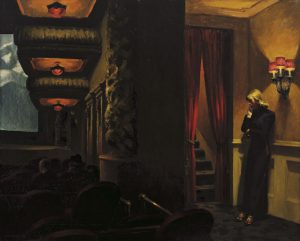 ive that reflects feasible realities, fabricating a sense of uneasiness and disturbance in worlds not that far off from our own. This can be displayed in his story “A Precursor of the Cinema” which depicts a frighteningly interactive form of painting; a cinematic masterpiece of perturbed art brought to life. You surrender to his words, lulled into a false sense of safety, and before you know it, something absolutely crazy has just taken place.
ive that reflects feasible realities, fabricating a sense of uneasiness and disturbance in worlds not that far off from our own. This can be displayed in his story “A Precursor of the Cinema” which depicts a frighteningly interactive form of painting; a cinematic masterpiece of perturbed art brought to life. You surrender to his words, lulled into a false sense of safety, and before you know it, something absolutely crazy has just taken place.
“A Precursor of the Cinema” visualizes the concept of motion pictures in an entirely new way, although not new? Rather, Millhauser depicts what moving images had the possibility of being, taking an idea once familiar and turning it into something not recognized by today’s standards. This almost feels like a “what could have been” or even “what might be” situation. This reality is not unfathomable, although harboring fantastical qualities.
“He teases us, this man who is neither one thing nor another, who swerves away from the history of painting in the direction of the cinema, while creating a lost medium that has no name.”
The story takes place in a time prior to our own and gives off the impression of a past age. We follow the narrative of an artist by the name of Harlan Crane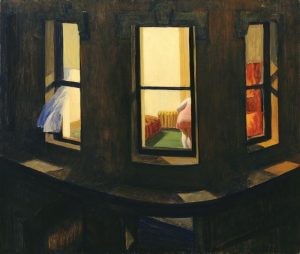 , a painter who has uncovered the ability to move his work. He has essentially created a way to make interactive art through means not properly defined and concrete, but it’s best to assume that fantastical technology plays some formative part.
, a painter who has uncovered the ability to move his work. He has essentially created a way to make interactive art through means not properly defined and concrete, but it’s best to assume that fantastical technology plays some formative part.
His works, while beginning as docile and harmless, began to transition into properties much more ominous, giving the impression that something baleful and menacing is unfolding. Which is an interesting concept, given the history that art has had in terms of societal censorship. Plato once famously stated that because art is an imitation of life and events, it creates an illusion of ordinary experiences, and therefore, it is a copy of a copy of a form. An untrue imitation, a falsification of natural life. So in theory, works of art at best are entertainment, and at worst a dangerous delusion.
“The time may be near when the image will be released from its ancient bondage to cave wall and frame and screen, and a new race of beings will walk the earth. On that day the history of the cinema will have to be rewritten, and Harlan Crane will take his place as a prophet.”
Mar 31st, 2022 by Jess Munley
“A Change in Fashion” by Steven Millhauser features, as usual for Millhauser, a wild concept that is obsessed over. In this case, it is a new form of women’s fashion that creates the Age of Concealment. Women start to wear large clothes that erase their forms underneath, making it impossible to determine what they look like. Their heads are slowly covered more and more until they are truly just walking, shapeless blobs of fabric. The narrator discusses its sharp contrast to the more revealing and provocative clothing worn by teenage girls in the past. He also comments on the seductiveness of these women being covered up, a sort of forbidden fruit that contain knowledge you crave. I think this part of the story could be a commentary on a common occurrence in human history and human behavior. We want that which we can’t have or don’t know about. Women are already often treated as objects to be desired, and using their clothing to hide them was an interesting idea of Millhauser’s.
It was also interesting to consider how much control women really had in this situation. Yes, they are using their right to cover up to empower themselves, but it is still at a man– Hyperion’s– suggestion. I did enjoy that they were being so bold as to wear clothing the size of rooms and even buildings, but I wonder why Millhauser added in Hyperion’s character, and why Hyperion is a man. I feel that, for me, it detracted from what could have been a story purely about women being in control of how they are perceived by men. It is a fascinating idea, one that I’d love to see in real life, just to experience men’s reactions to it.
I think that was something the author captured accurately, by suggesting that men still saw women as sexualized beings even when they could only see their clothes. Just the idea of a woman is treated as inherently sexual in this story, and I don’t think it’s too far off from reality. I’m curious if this was Millhauser’s intention, or if his own worldviews are bleeding into his story.
I think the ending was an accurate depiction of what would really happen. Women’s dresses grow to enormous sizes and they use this to their advantage, to go hang out in their bathrobes at the neighbor’s house. And, of course, they are only discovered when men break boundaries and take a forceful bite of the fruit they have been forbidden from touching.
Mar 31st, 2022 by accazares9715
‘A Change in Fashion’ by Steven Millhauser takes the reader to the common issue of fashion. There are always times in which fashion seems to cross the line between fashion and nonsensical clash of fabrics, and Steven Millhauser seems to emphasize that concept. Fashion is a continuously changing concept that can change from generation to generation, and in this story we are taken to a world in which fashion is determined by how much can be hidden.
One of the themes which struck out to me was the idea that women felt comfortable in the idea that hiding oneself from the gaze of men was, and at the same time it is a form of revealing oneself without seeing skin. This was interesting since it seemed to imply that hiding in cloths could also be sexualized in the way that revealing cloths is sexualized. Additionally, his descriptions of the cloths often seemed to be satirical and overly exaggerated to make fun of the way in which this happens in real life. How women buy pieces of cloths in order to feel more beautiful or more in touch with time regardless of how inconvenient the garment actually is.
There was also a theme of change. The women who had been in the time of revelation, have become weary of the time and desire for something different. Hence, the sense of fashion changes to overly modest, in which everything is hidden from view. Which is also illustrated by the cloths and how they are a form of change from styles which were once popular. Some of the ways in which cloths come to life is to bring back styles which used to be in style, but adding new things to these garments. Which was done in the story, and shows the desire to bring back things from the past, while still maintaining a form of change from the original.
Mar 31st, 2022 by Emma Alexander
“A Change In Fashion” by Steven Millhauser once again made use of a collective third person narrator that describes things much like a documentary. The focus of this story was on fashion, and how it seems to change drastically over time. Fashion trends come and go throughout the decades, and often times certain trends come back in a slightly different way. Millhauser addresses this in the beginning of the story:
It was as if, after half a century of reckless exposure, a weariness had overcome women, a yearning for withdrawal, a disenchantment with the obligation to invite a bold male gaze.”
That being said, I found it interesting that it focused on women’s fashion in particular. Women’s fashion in more recent years has been somewhat revealing, not leaving much to the imagination, whereas the fashion change that takes place in this story suggests something else entirely. The fact that more of the body is covered makes it more interesting; it’s the not knowing that makes it more enticing. This idea becomes more vivid and tangible as more advancements are made to women’s dresses. Some are suspected to have miniature rooms underneath the skirts, and some dresses become so large that they cover whole houses and lawns, making the women seem to disappear altogether. The thrill of the dresses makes them a work of wearable art, and this fashion influences society for quite a while.
However, this too eventually fades, and the large, and overbearing dresses fade into barely a memory. Only a few seem to recall that the change had ever even happened. This is very similar to historical events. The people that lived during that time carried the memory, but over time the recounting of events warped and changed, or completely faded altogether.
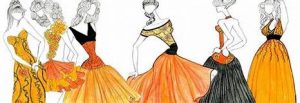
Mar 31st, 2022 by zadarden1398
“A Change in Fashion” by Steven Millhauser was a humorous composition that dramatized the ever-changing style of clothing. This was not an easy piece to read at first, and I became confused on several occasions. Due to my lack of knowledge about Elizabethan fashion, it was hard for me to picture the dresses he described. The author also discusses the Elizabethan period, when certain aspects of a woman’s body were enlarged, and compares those clothes to some of the Contemporary fashion, which included large material folding. Clothes equivalent to those of the past. Teenagers assist in the reprocessing of fashion concepts since they are frequently dissatisfied with current fashion patterns and hues. They’re a good demographic to introduce risky “modern” trends to. Millhauser comments on the fashion trends that many people buy into by overemphasizing various fashion trends. For instance, the author mentioned a clothing that was said to contain a side door that led to a sitting area with a lamp. This is a very absurd dress concept. Millhauser suggested completely covering the recipient’s face with cloth folds that could be folded back over your house. Some of the outfits mentioned were too enormous to wear indoors which had to be worn elsewhere. Men who thought they were talking to ladies were sometimes talking to a dress that was standing up on its own. Dresses that are too tight or high heels that are too high are worn by women to look stylish. Millhauser is correct when he accidentally states that we are obsessed with our bodies. It isn’t necessarily a terrible thing. As absurd as it may sound, fashion designers persuaded women to buy these outfits in order to stop worrying about their figures. Fashion designers persuaded ladies to buy these outfits so they wouldn’t have to worry about their figures. It may sound ridiculous, yet stylists, publication, and other organizations strive to persuade us that history’s fashions are essential.
Mar 30th, 2022 by MJ
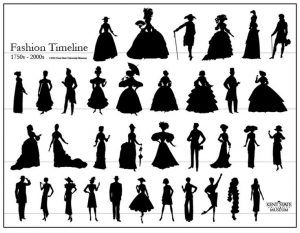
One thing Steven Millhauser is good at is taking the ordinary in our lives and spinning it on its head. “A Change in Fashion” takes the natural changes that happen in fashion. Women start dressing in more and more layers and covering up more. “It was as if, after half a century of reckless exposure, a weariness had overcome women, a yearning for withdrawal, a disenchantment with the obligation to invite a bold male gaze. In every skirt fold and blouse button, one could sense the new longing for hiddenness.” (171). Part of this story hits home as how women’s fashion almost always keeps the male gaze in mind. Even with more and more layers being added on, there is still a feeling of sexualization. Instead of sexualizing what is shown, it is the sexualization of what is hidden away.
A new hidden designer named Hyperion comes in and opens the door by being the first to make women completely hidden. This kicks off with other designers, hiding women more and more. Dresses get larger, more abstract. It gets to the point where the dresses become large enough that women can slip out of them unnoticed until someone checks. Eventually, they become more like pieces of art, and Hyperion is revealed to be just a random man who did not know anything about fashion. Upon googling Hyperion, you see he was the Titan of light. The idea of someone using a god-like name to usher in a new light of fashion.
Another theme of the story seems to be the human desire for new things and what better way to explore that than through fashion. Fashion is constantly changing throughout time and some styles come back. Even some of Hyperion’s fashions have elements of Victorian and Edwardian fashion elements in them. “Meanwhile the new dresses grew a little shorter, a little longer; slacks and blouses grew tighter, looser.”(178). Millhauser examines the changes in fashion with a fantastical element. Fashion trends frequently make returns and no matter how ridiculous they may get, elements of them may begin returning years down the line.